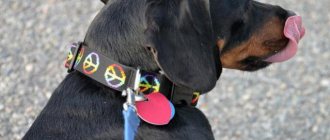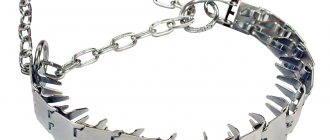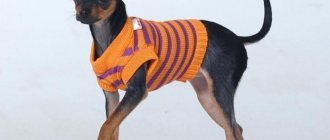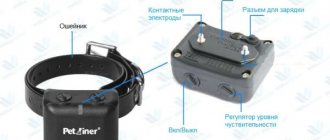At what age should a puppy be accustomed to a collar and leash?
Experts recommend introducing your pet to new objects for the first time at the age of one and a half months. Most likely, an unfamiliar thing on the neck will irritate the puppy at first, but the main thing is to show a little patience, do not punish, do not behave aggressively, and the efforts will be rewarded.
The training process, as a rule, begins at the age of three months, at which time you can accustom the baby to the toilet, his own place. However, it is impossible to go outside with a puppy without a collar and leash, which is why already at one and a half months they put a collar on the pet for the first time. The process of a baby’s adaptation to new objects is divided into several stages to make the task easier and not to traumatize the puppy’s psyche.
If your puppy has not yet been vaccinated or is not fully vaccinated, you can and should still walk him.
Choosing a Collar
The choice of collar is of great importance. Keep in mind that the dog will grow, and for the first lessons there is no need to choose expensive, special equipment. The most comfortable will be a flat and lightweight collar that will not cause discomfort.
Avoid chain-shaped collars; a small puppy will most likely not want to wear one, because hair fibers getting into the chain links cause considerable discomfort.
Determining your collar size
A procedure such as determining the size of a collar comes down to measuring the girth of the animal. As a rule, you need to add 5 centimeters to the resulting dimensions. However, there are some subtleties in the sizing process. So, you should take into account that the leather collar must fit tightly, otherwise the dog will simply pull it off. In order to choose the right metal accessory, you need to add 6-7 centimeters to your neck circumference. When purchasing a parfors, you must take into account that this accessory is located quite high. Therefore, measurements are taken under the throat. To train and train a puppy, dog breeders use a parforce and a muzzle. A strict collar can be used for training an animal whose age exceeds 3-3.5 months. It’s difficult to say which collar is better. It all depends on the dog.
In conclusion, I would like to note that the collar is a reflection of the temperament and character of the animal itself.
Stages of training
The sooner you start training your puppy, the easier it will be for you in the future.
It is not surprising that a pet's first acquaintance with new things causes protest, but this is a completely predictable reaction. To make the dog’s habituation process as easy as possible, experts recommend breaking it down into several stages.
Adaptation
It is necessary to remember that the issue will not be resolved in one day; regular practice will be required when the dog is calm or playing. A reward system should be introduced from day one. There are several reward options for a pet, each owner can choose the one that the puppy likes.
How to reward a puppy:
- Every time your puppy diligently follows your instructions, give him a treat.
- Surely the puppy has a favorite game, after the lesson with the collar - play with the pet.
- Clicker rewards are used to communicate with a dog without physical contact, in which case the owner praises the puppy through a beep.
Now the puppy should gradually get used to the collar. If your pet is nervous and tries to take off his new clothes, don’t worry, try to calm the dog down.
How to calm a puppy:
- Distract your pet with play.
- Reward your puppy every time he agrees to wear the collar.
- Check whether the puppy is comfortable in the collar; it should fit snugly to the neck, but not restrict movement.
A puppy can be at home wearing a collar only if someone is looking after him; if you leave and leave the pet alone, the collar must be removed.
Each puppy's attitude towards a leash is individual - some categorically do not want to be deprived of freedom of movement, while others do not even notice the new object. In any case, the first time you attach the leash to the collar, throw the free edge and let the puppy run around and understand that the new object is not dangerous. During the first days, be sure to make sure that the leash does not entangle the puppy while playing and running. Give your dog a treat each time you remove the leash.
Leash training outdoors
As soon as the puppy begins to walk calmly in his harness at home, on average it will take four days, try going outside with your pet. What nuances should you consider when going for a walk for the first time with a collar?
KEEP CALM
Very often, dogs that calmly respond to a leash at home, on the street begin to behave completely differently - they whine, bark, do not want to walk, but simply lie down on the ground. The owner’s task is to remain calm, not scold the dog, and not use violence. Remember that many dogs behave like their owners; if the person is calm, most likely the puppy will follow his example.
REMEMBER ABOUT REWARDING
When going outside, take a treat with you, try to calm the puppy down with a treat, or distract the puppy with a game. Pieces of sausage or cheese are suitable as a treat.
BE CONSISTENT
React adequately to every action of the puppy - if the dog obeyed you, pet it and reward it, and punish it for misdeeds and bad behavior. There are certain methods of dealing with bad habits; they are effective, but only on condition that they enter the system and are used constantly.
Training an adult dog
Only with practice will you help your dog quickly master everything he has been taught. To do this, whenever possible, go for a walk with your pet, it is advisable to do this several times a day, remember to remain calm and follow a few simple recommendations.
When walking, be slightly ahead of the dog, thereby demonstrating your control over the situation. Feeling the superiority of the owner, the dog will be obedient. Most likely, at first you will need to tighten the leash a little when your pet begins to tug on it. If the dog begins to behave inappropriately, calmly call the puppy and, after following the order, reward it with a treat. While walking, do not be distracted by your mobile phone and do not show anger or irritation.
From about three months, start shortening the leash and teach your dog the command “Here!”
Keep a close eye on other owners and dogs . It happens that the pet begins to get nervous and react inadequately to the excited state of other puppies, rushing towards them, trying to join the game. If you notice that the dog's owner cannot cope with it, distract your pet with a treat.
Choose your ammunition wisely . The length of the leash should vary between 1.22-1.83 meters. In most cases, this is the length of the leash that allows you to control the dog’s behavior. It is better not to use strict collars; in most cases they are necessary to correct the behavior of adult dogs with a complex character.
Why you should not use retractable leashes:
- The owner cannot always have time to react to the dog’s movement; as a result, the pet ends up in a dangerous place, for example, on a roadway, in a matter of seconds.
- In the event of a fight between dogs, the retractable leash will quickly become tangled and it will no longer be possible to roll it up.
- A strong pet will easily tear the cord from the plastic base.
- If you recklessly grab a quickly unwinding leash, you can burn your hand.
- The dog does not feel when the length of the cord ends, and if it accelerates, it can get injured.
- A retractable leash practically does not restrict the dog’s movement; other pets may see this as a threat and begin to sort things out.
The optimal choice is a classic two-meter leash, ending with a loop that can be put on the hand.
We take the dog by the collar
This is one of the main stages, since the owner will certainly have to perform this action every day, when at the end of the walk he needs to go home. Most puppies perceive a hand sharply extended towards them as a source of danger, because at this time the person comes very close, looks into the eyes, grabs the neck, that is, invades personal space.
Some dogs will run away and some may react aggressively. The owner’s task is to convince the puppy that his actions do not pose a threat. It is not recommended to use game reward in this case, since in the future the dog will get used to breaking free and running away cheerfully after the owner takes it by the collar. Rewarding with a treat will help your pet remain calm and respond correctly to touching the equipment.
Algorithm of actions:
- Prepare a treat - the pieces should be such that the dog can swallow one without any problems.
- Sit next to the dog, slightly to the side of it, slowly reach out to the collar and touch it.
- When your puppy lifts his nose away from your hand, give him a treat and release the collar.
- Repeat the same, but grab the collar with your other hand. Change hands until the puppy is no longer distracted by the hand touching the equipment.
- Now you need to ensure that the pet does not look at the hands, but only into the eyes of the owner. To do this, take the puppy by the collar and hold it until he looks at your face in surprise. At this point, praise the puppy and give him a treat. If your pet doesn’t look at you for a long time, prompt him - show him the hand in which you are holding the treat and bring it to your chin. As soon as your dog follows your hand with his gaze, immediately give him the treat.
- The exercise needs to be practiced five to ten times daily, changing positions, touching the collar from different sides. Afterwards, you can complicate the task - if the pet is trained in the command “Come to me!”, add a touch to the collar to it. Call your dog, grab it by the collar, praise it, give it a treat and release it.
Possible problems
The puppy constantly pulls on the leash
Every time the pet resists and does not want to go in the indicated direction and begins to pull on the leash, stop, but do not pull the dog. Let the pet understand that any attempts to go in the opposite direction from the owner end in nothing. Call your baby over and give him a treat; if you use this pattern constantly, the dog will soon wean itself off the habit of pulling on the leash.
The puppy does not want to go and demonstratively does not move
Use treats and your patience. As soon as the dog stops, move away from it a few steps and invite the puppy to come to you to take the treat. When your pet complies with the request, continue your walk. Only by remaining completely calm can you teach your puppy not only to walk on a leash, but also to enjoy walks.
How to properly put a collar and leash on a dog
How quickly the pet will get used to the new thing depends on how well the collar is put on the dog for the first time.
To begin, simply place the collar in front of the puppy and wait a few minutes, during which time the pet will get acquainted with the new thing and make sure it is safe. Be careful that the puppy does not start playing with the collar, otherwise in the future he will continue to treat the equipment as a toy. If the dog is actively chewing on the new thing, take the collar and stop trying to put it on the puppy’s neck for a while. After about ten minutes, when the dog stops showing interest in the thing, try again.
Stock up on treats, call the puppy, give him something tasty and show him the collar. Just before attempting to put on the harness, reward your dog with a treat again. You need to handle the puppy with extreme caution; any careless movement will scare him away, and then you won’t be able to try again for a long time. For the first time, it is advisable to try to put on the collar without touching the puppy with your hands. If your pet agrees to try on the equipment, be sure to treat him with a treat.
If the dog gets scared and runs away, use one of the following techniques:
- Use the collar as a mark, and when the puppy approaches it, he gets a treat.
- Take the collar in your hand, stroke the puppy with it and feed it something tasty.
Such actions will help the dog quickly get used to the equipment and calmly tolerate the touch of the collar. As soon as you feel that your pet is not afraid of the object, try putting it on and immediately taking it off.
At the same time, allow the puppy to go to a safe place and do not disturb him for a while.
The next day, put the collar on for a few seconds, following a similar pattern - don’t skimp on treats, show maximum calm and no aggression. After another day, try putting the collar on the dog and playing with it for a while; if the puppy does not try to remove the equipment, leave the collar on the pet, and if there are signs of anxiety, distract it with play or a treat.
When the dog feels completely calm in the collar, do not take it off even at home, but only if there is someone in the room.
Be sure to consult whether a dog can be in a collar for a long time in a row; for example, dogs of hunting breeds must be freed from equipment while working in the field so as not to be injured.
How to choose the right collar for a puppy
It is very important to choose the right collar for your puppy. For small puppies, purchase narrow and light straps. For larger pets, thicker leather, canvas or nylon collars are suitable. For large puppies, choose two-layer and well-stitched straps made of leather and canvas or nylon.
For animals with soft and flowing fur, it is better to purchase collars that are round in cross-section. They are usually made of soft leather. The seam on such a collar should be on the outside.
It is necessary to pay attention to the quality of the material. You should not choose the cheapest collar, as it may tear or cause skin irritation. The material should be soft, but at the same time durable enough.
Features of materials
Each material from which collars are made has its own characteristics:
- Nylon. This material is very strong, soft and durable. Nylon collars are the most affordable. Another advantage is the huge number of different colors. The nylon collar is not afraid of water and does not lose its appearance even after getting wet.
- Leather. Classic material for making collars. Genuine leather is soft and durable, but has a fairly high cost. Leather collars are less durable and quickly lose their original appearance due to frequent contact with water.
- Metal. Such collars are quite durable, but this only applies to chains made of high-quality material. Cheap metal collars quickly rust, and links can fall apart due to poor welding.
- Tarpaulin. These collars have the lowest cost, but their service life is quite short. Canvas straps quickly lose their original appearance and become rough after getting wet. However, such collars have an advantage - they are very strong.
Some collar models combine several materials at once: leather and canvas, leather and nylon, etc.
Collar size
In order to choose the correct collar size, you need to measure the circumference of the puppy's neck with a soft measuring tape. It is applied tightly to the skin. If the pet has very thick fur, it is parted and measurements taken.
REFERENCE! The correct collar length is 3-7 cm longer than the neck circumference.
Breed characteristics
Some breeds have their own neck structure, and this should be taken into account when choosing a collar. For dogs such as Greyhound, Italian Greyhound, Whippet and other animals with thin necks, straps with an extension in the middle (herring model) are suitable.
For long-haired breeds (collie, bobtail, sheltie, border collie, etc.), round collars or metal chains with a long link are suitable. For very large animals (Caucasian Shepherd, Boerboel, etc.), it is better to choose two-layer and well-stitched ammunition made of leather and nylon or canvas.
Common Mistakes
| Error | Consequences |
| Incorrect tightening of the collar. | If you put the collar on too loosely, the puppy will simply jump out of it. If you tighten it too tightly, there is a high risk of injuring your dog. In addition, the pet will perceive the collar as a source of unpleasant sensations. |
| Roughness when putting on and taking off the collar. | This will lead to the fact that you will not be able to force your pet to put on the equipment and you will have to take measures to correct the dog’s behavior. |
| Sudden jerks while walking. | The dog will remember that the collar is painful and unpleasant. |
| Compulsion. | This will lead to the dog developing the wrong attitude towards the collar. |
| Permission to play with collar and leash. | The owner must show with every action that the equipment is a safe signal for a walk. |
How to teach an adult dog to walk on a leash
The main rule in training and getting used to a collar is consistency. It is important to be patient and not expect too quick results. There are several ways to learn how to train your pet.
Loyal way
This is the most loyal method that will help maintain the puppy’s trust in its owner. But you need to be prepared for the fact that it will take a long time and patience. Training is based on the following actions:
- The owner must call the puppy by name and attach a collar and leash to it. It is important at this moment to pet and speak affectionately to the pet in order to build trust.
- While walking, when pulling on the leash, you need to stop. In this way, the puppy will understand that the owner’s behavior depends on its movement.
- The owner must let the pet feel that moving slowly nearby will be more effective than running quickly and constantly stopping.
- Every time you stop due to tension, you need to give your dog a treat.
Gradually, during the learning process, goodies are exchanged for praise.
The hard way
This method is most suitable for adult dogs. It is used for animals aged four months and older. As soon as the dog starts to run to the side, he is jerked sharply. It is important to act in such a way as not to cause pain.
Hard way of training











